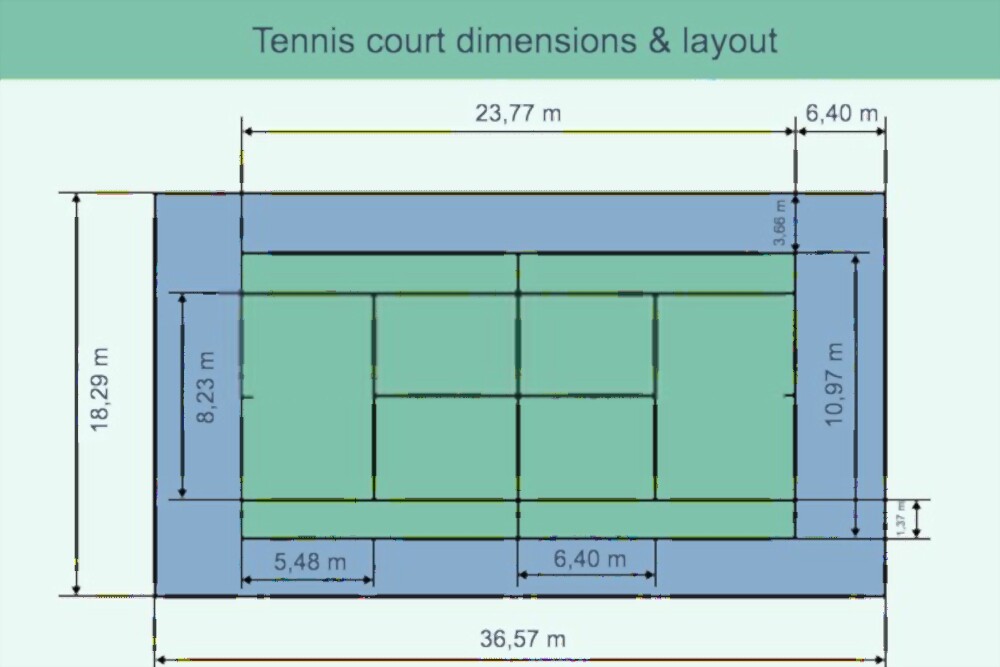Tennis court dimensions are an important part of the sport. Knowing the proper dimension of a tennis court can help players understand the game better and be able to play it properly. As such, understanding the standard dimensions of a tennis court is essential for any player looking to improve their game.
Tennis Court Dimensions & Markings
In tennis, the court is typically 78 feet long and 36 feet wide for a total area of 2,808 square feet. This site is only used for doubles matches; singles courts are slightly smaller. The singles court is a rectangle measuring 78 feet in length and 27 feet in width, with an area of 2,106 square feet. It consists of several components that must be taken into consideration.

Let’s explore each of these elements in more detail.
The Components and Markings of a Tennis Court
A standard tennis court includes the following components:
Baselines:
The outermost lines of the court, mark the limits of play. For doubles, these lines are 36 feet wide and for singles, these lines are 27 feet wide.
Sidelines:
These lines are 39 feet long for singles and doubles as well and run parallel to the net and are located between the baselines and the doubles alleys.
Doubles Alleys:
The areas near the singles sidelines, but outside the doubles sidelines.
Net:
A net that is 3 feet (0.914 meters) high at the posts and 3 feet 6 inches (1.067 meters) high in the center, which divides the court in half lengthwise.
Posts:
Posts are the poles that hold the net in place and these are 3.5 feet tall and no more than 6 inches wide.
Service Boxes:
Two equal boxes at the center of the court, are used for the starting point of each point.
Center Service Line:
This 42 feet long (21 feet on each side of the court) line runs parallel to the net and is located halfway between the service boxes.
Center Mark:
A small 4 inches long mark is located on the center service line and used to determine the serving side of the court.
Service Line:
This is a 27 feet wide line that is aligned parallel to the net and is located inside each service box and
Tarp:
The tarp is a large sheet of material that is placed over the court to protect it from rain or other elements.
Different Areas of a Tennis Court
Doubles Alley:
The doubles alley is the area situated between the singles and doubles sidelines. The double alley area is around 39 feet x 4.5 feet (175.5 square feet).
Right & Left Service Box:
The center service line divides the court into two equal-sized boxes, the left and right service boxes which are 21 feet x 13.5 feet (283.5 square feet).
No Man’s Land:
This area is 18 feet x 27 feet (486 square feet). If you’re just starting out in tennis, you may hear someone shout “Get out of No Man’s Land!” This is the large box situated between the baseline and the on-service line of the court. It is generally not recommended to stand in the area near the net, as you will be unable to hit a powerful groundstroke from this distance and equally struggle to maintain accuracy when volleying.
Related: Kickball Field Dimensions
History of Tennis
Tennis has a long and storied history that dates back to the 12th century. The game is believed to have originated in France, where it was known as jeu de paume, which means “game of the palm.” This early version of tennis was played with the hands rather than rackets, and the ball was made of leather and filled with feathers.
Over time, the game evolved and began to resemble the modern sport we know today. In the 16th century, rackets were introduced, and the ball’s composition was changed to rubber. The modern scoring system, where players earn points by winning games, sets, and matches, was also established during this time.
In the late 19th century, tennis began to gain popularity as a sport in England. The All England Lawn Tennis and Croquet Club, which still exists today, was established in 1877, and the first Wimbledon tournament was held in 1877.
The first US Open was held in 1881, while the first French Open was held in 1891. The Australian Open was first held in 1905, and the first official Davis Cup competition was held in 1900.
The sport continued to evolve and gain popularity throughout the 20th century, with the introduction of new technologies such as synthetic racket strings and the use of television to broadcast matches. Today, tennis is one of the most popular and widely played sports in the world, with millions of fans and numerous professional tournaments held each year.
FAQs
What is a tennis court and its dimensions?
The dimensions of a standard tennis court are as follows:
Length: 78 feet (23.77 meters)
Width: 27 feet (8.23 meters)
The court is divided into two equal halves by a net, which is placed 3 feet (0.91 meters) high at the center.
What are the dimensions of the ITF tennis court?
The International Tennis Federation (ITF) does not have specific dimensions for a tennis court. The ITF provides guidelines and regulations for tennis courts, but the dimensions can vary based on factors such as court surface, location, and level of play.
Length: 78 feet (23.77 meters)
Width: 27 feet (8.23 meters)
The court is divided into two equal halves by a net, which is placed 3 feet (0.91 meters) high at the center.
How do you measure a tennis court?
To measure a tennis court, you can use a measuring tape or a measuring wheel. Start by measuring the length of the court from baseline to baseline, which should be 78 feet (23.77 meters). Then measure the width from sideline to sideline, which should be 27 feet (8.23 meters).